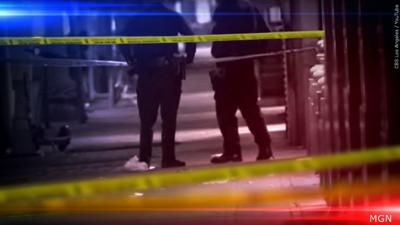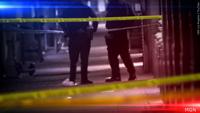BALTIMORE (AP) - Joe Johnson-Winfield remembers when west Baltimore’s Pennsylvania Avenue attracted locals and tourists alike to its renowned jazz clubs, upscale shops and vibrant nightlife. Back then, the bustling commercial strip, also known as The Avenue, was a Black cultural hub frequented by civil rights leaders.
Over a half-century later, nearly everything has changed.
On his way to the store for cat food Monday morning, Johnson-Winfield walked past the scene of a Saturday evening shootout that killed two people and left three others injured.
At least one of the gunshot victims, a young mother, was an apparent bystander. She was waiting for takeout with her two small children when gunfire broke out, according to police. She tried to drive away, but a bullet left her critically wounded behind the wheel. Her vehicle continued down the block before crashing into a pole. The children - a baby and a toddler - both suffered serious injuries from the crash. The woman died Monday in the hospital, police said.
Less than two weeks earlier, a man was stabbed to death at the same busy intersection, which includes a subway stop, corner stores and other businesses.
The brazen displays of violence left residents on edge, worried for their safety and further frustrated at the current state of Baltimore’s Upton neighborhood, which emerged during segregation as a bastion of Black culture and entertainment. Its cultural artifacts include the childhood home of Thurgood Marshall, the first African American appointed to the U.S. Supreme Court, and a bronze statue of jazz legend Billie Holiday, who also had roots in west Baltimore and performed at nearby clubs.
But since Upton’s heyday, the area has experienced a steady decline driven by urban flight and growing disinvestment.
“It breaks your heart,” said Johnson-Winfield, 65, a semi-retired hair stylist and lifelong resident of the area.
He gestured toward nearby blighted buildings and overgrown lots, familiar signs of poverty in an environment largely defined by the local drug trade and its devastating impacts: addiction, homelessness and violence. People were milling around on the sidewalks, some exhibiting obvious signs of substance abuse.
Several makeshift memorials commemorated the recent victims with balloons, candles, liquor bottles, stuffed animals and photos. Trash bins lined the sidewalk, overflowing with discarded yellow crime tape.
“This city is just one big memorial, candlelight vigils every week,” Johnson-Winfield said, shaking his head sadly at the number of young men carrying guns and resorting to violence in Baltimore, which recently recorded over 300 annual homicides for the eighth consecutive year.
After losing younger relatives to gun violence, he sees no easy solution. He believes police officers should do more to address obvious criminal activity, but he also acknowledged the challenges they face, especially in areas that seem heavily saturated with guns and drugs.
The Upton of his childhood was a different place altogether. The neighborhood rose to prominence in the early 1900s and its heyday lasted into the ’50s and ’60s.
“It was a hub,” Johnson-Winfield said. “On Friday and Saturday nights, people would get dressed to the nines and hit The Avenue.”
He recalled shopping with his family and sampling different cuisines at their local public market. The food hall now sits largely vacant next to the Upton subway stop, with several nearby corner stores and takeout joints offering little more than fast food, he griped. But officials announced plans last year to renovate the building, an investment they hope will spur additional revitalization in what was once Baltimore’s preeminent Black business district, filled with retail shops, grocery stores and restaurants.
Other initiatives to preserve Upton history and stimulate positive development are ongoing, including its designation in 2019 as an arts and entertainment district, which officials said would provide tax breaks and other incentives to attract artists. But after witnessing decades of decline, Johnson-Winfield and other residents are skeptical.
He said some business owners left the area after social unrest broke out along Pennsylvania Avenue following the 1968 assassination of Martin Luther King Jr., when the area experienced widespread looting and destruction. A confluence of factors helped place the neighborhood on a downward trajectory, he said.
Adrian Ferrell, a local minister, said the recent violence pushes him to keep showing up in underserved Baltimore communities, trying to instill hope.
“How many more must die for some to live,” he bellowed into a microphone Monday afternoon at the scene of Saturday’s shooting. He questioned how the city would respond if more of its homicide victims were white.
Ferrell said he speaks openly about his past transgressions, including drug sales and other crimes, because he wants to show people change is possible.
But many young men growing up in poverty struggle to envision a future beyond the environment they’re raised in, said Kenneth Taylor, 58, who often hangs out along Pennsylvania Avenue. He said the community needs more help and called on city leaders to invest more in after school programs, recreation centers and job opportunities for youth.
“In Baltimore, you’ve got the haves and the have-nots,” Taylor said - often with just a few blocks separating them in a city crisscrossed by stark racial and economic divides.
To address a surge in gun violence that began in the wake of Freddie Gray’s 2015 death in Baltimore police custody, city leaders have pursued a number of initiatives and increased funding of existing anti-violence efforts. Last year, they reorganized a mediation program that deploys violence interrupters to intervene in disputes and launched a “focused deterrence” strategy that offers services, mentoring and other supports to young men at high risk of violence.
Outside the Upton subway station Monday morning, Taylor pointed to a sign that describes the neighborhood’s “glory days” and directs visitors to learn more about the “Baltimore African Americans who helped build the city and changed the face of American music, art, literature and politics.”
Several yards away, blue and orange balloons commemorated the man who died from stab wounds in early January in a display of violence that occurred during daylight hours. Police later released surveillance video showing two suspects leaving the scene, but they haven’t announced any arrests.
When gunfire erupted Saturday evening, two men were injured, one fatally, while standing outside near the intersection, according to Baltimore police. Moments later, a group of people fired back from a short distance away. The young mother killed was caught in the crossfire while trying to escape with her children.
Baltimore Police Commissioner Michael Harrison said detectives are investigating who was the intended target.
“What we need right now is information from our community,” Harrison said at the scene Saturday. “We know people heard something. We know people saw something.”
Police released surveillance images Tuesday morning showing three suspects who allegedly returned fire after the initial gunshots.
Mayor Brandon Scott, a Baltimore native who has made public safety a top priority for his administration, called on Black men to stand together against gun violence. He questioned when people will stop shooting each other over petty disputes.
“We as a community, as people, we’ve got to be better,” he said.



